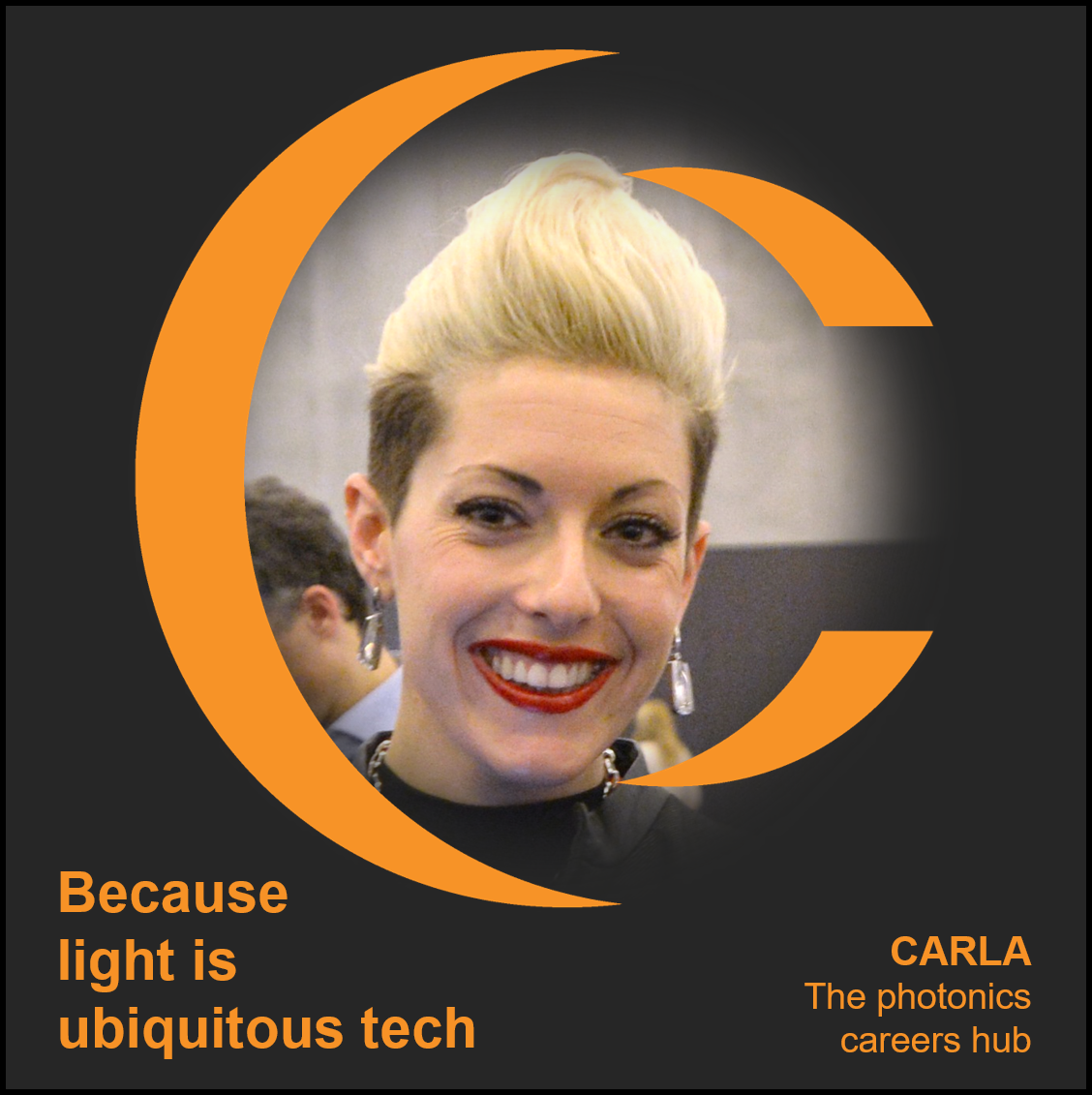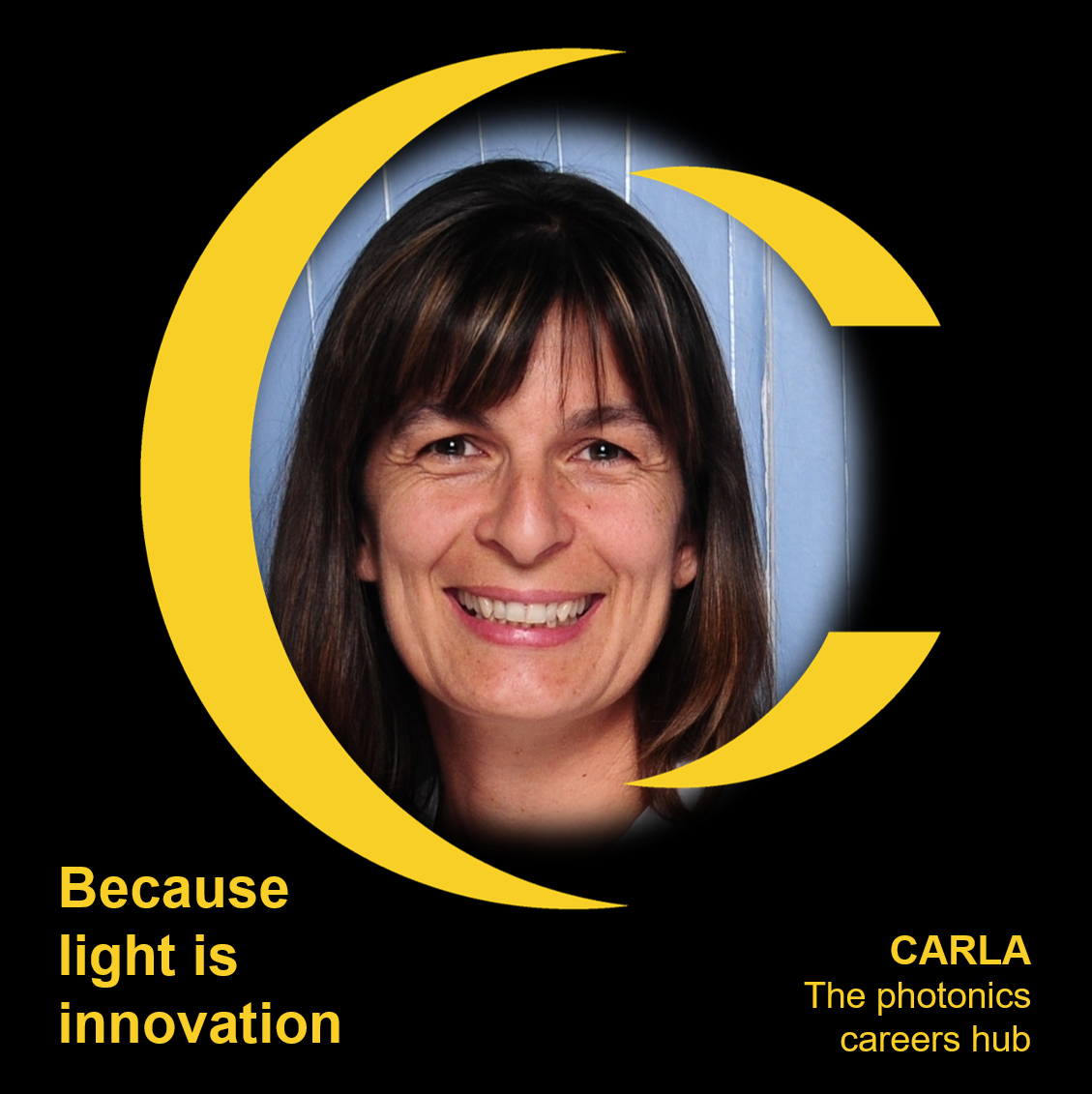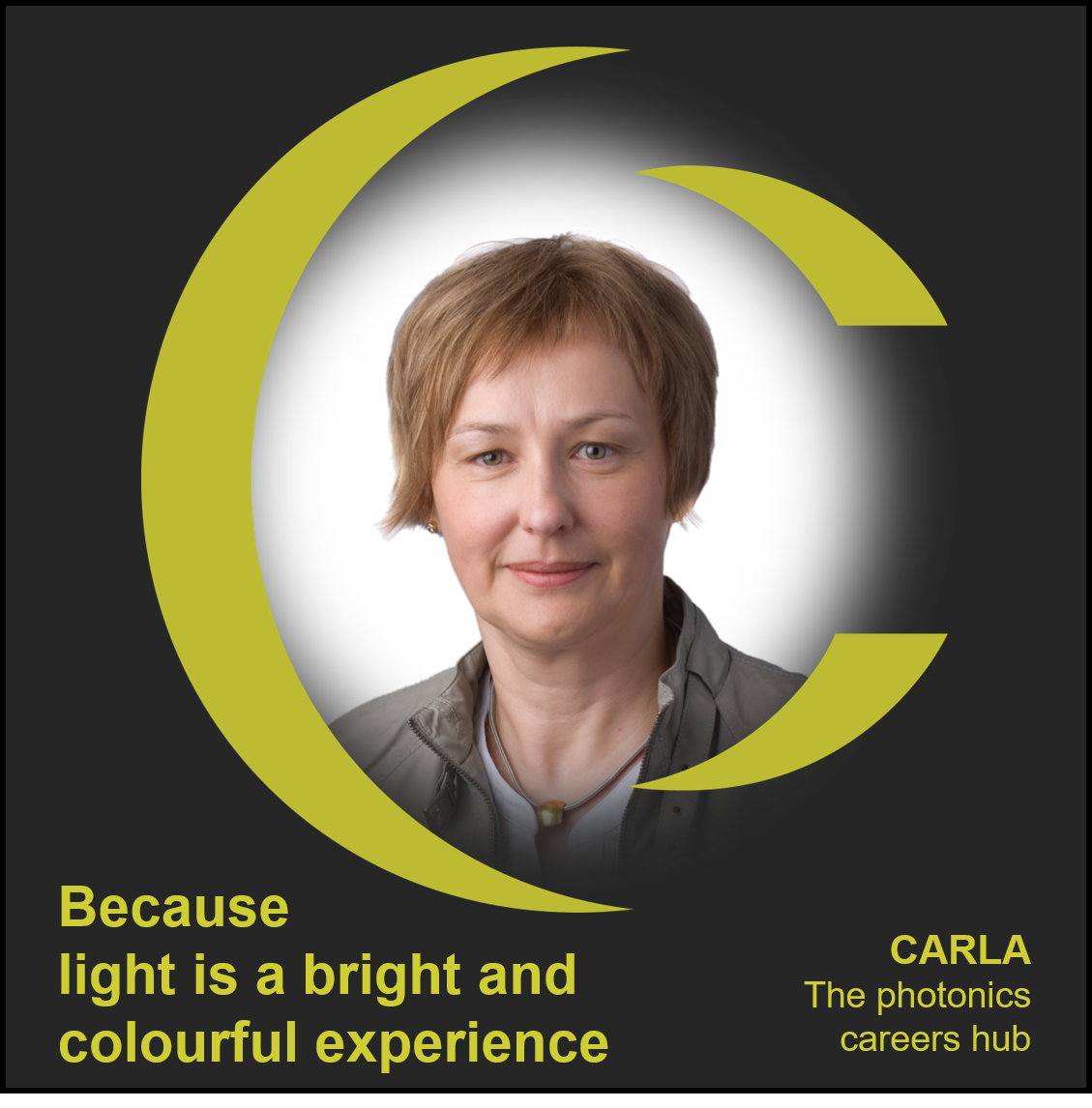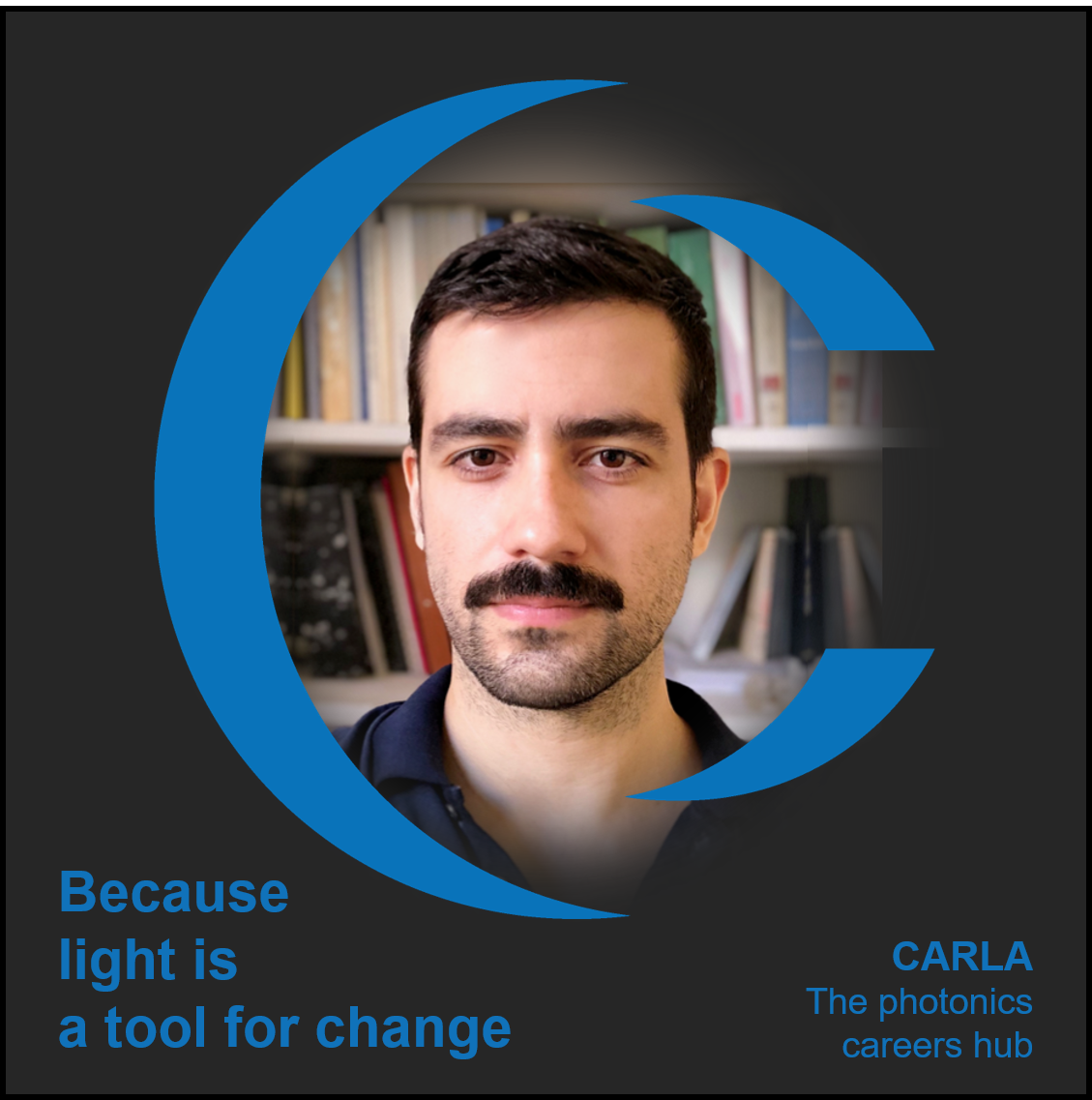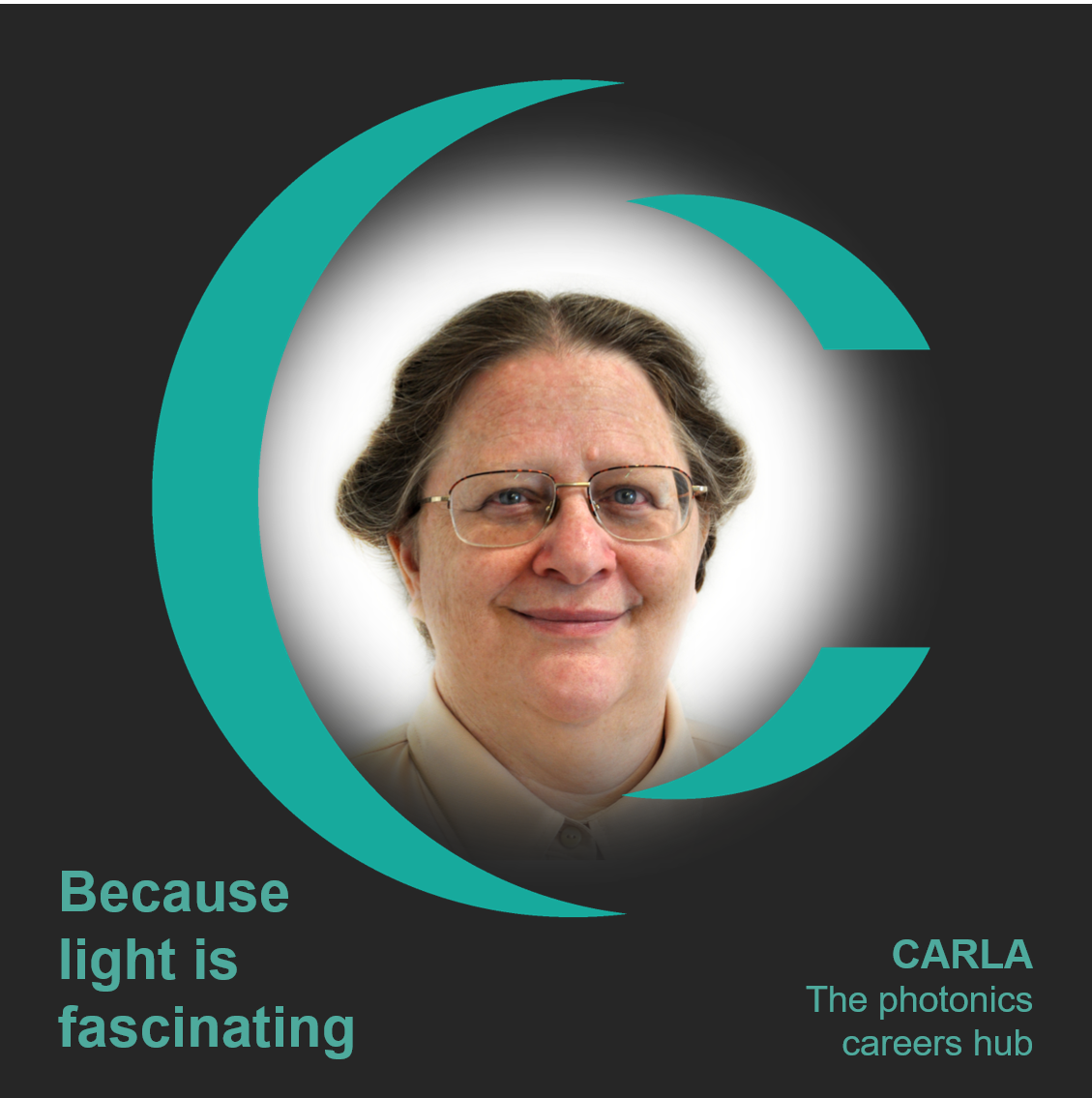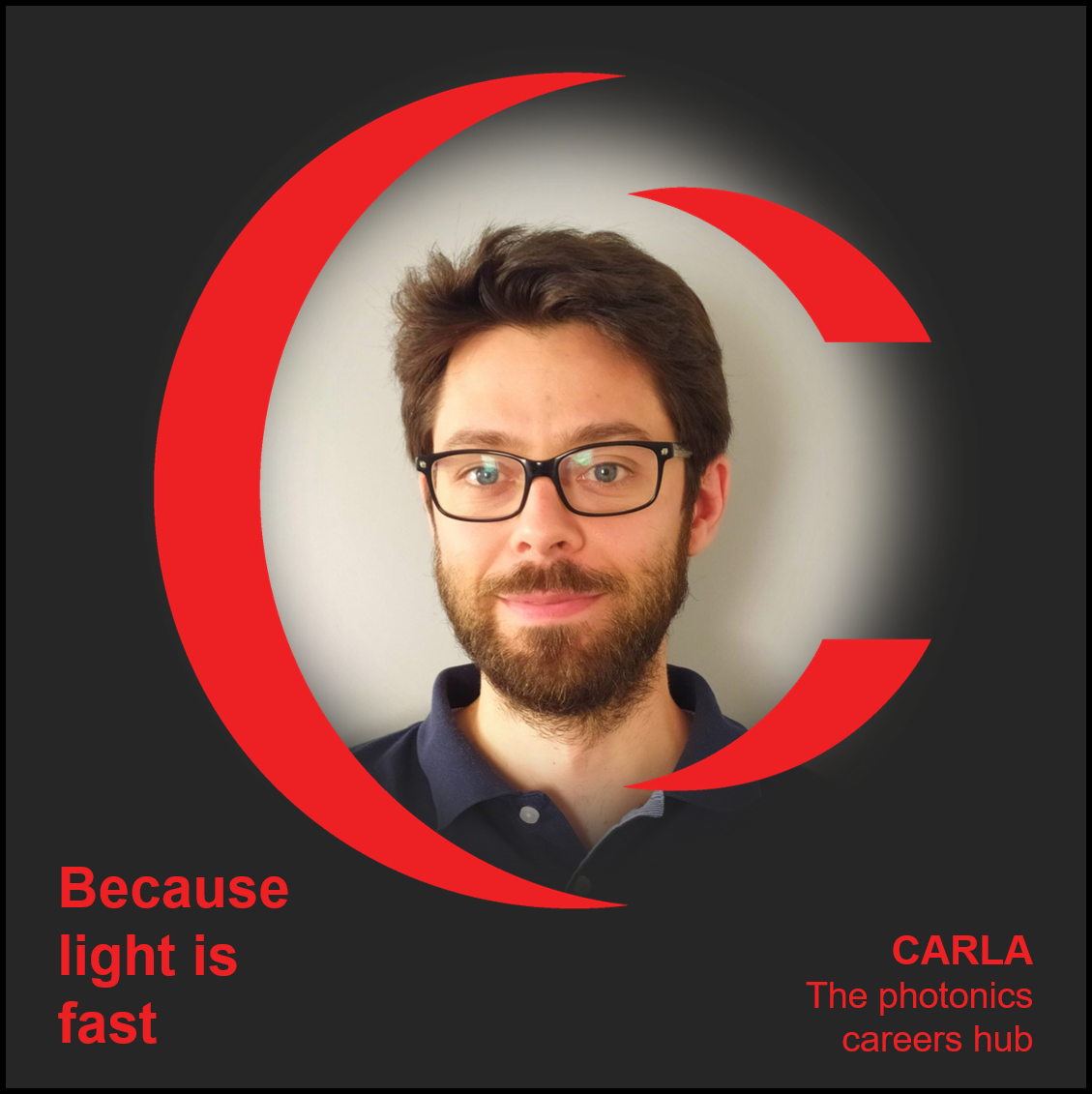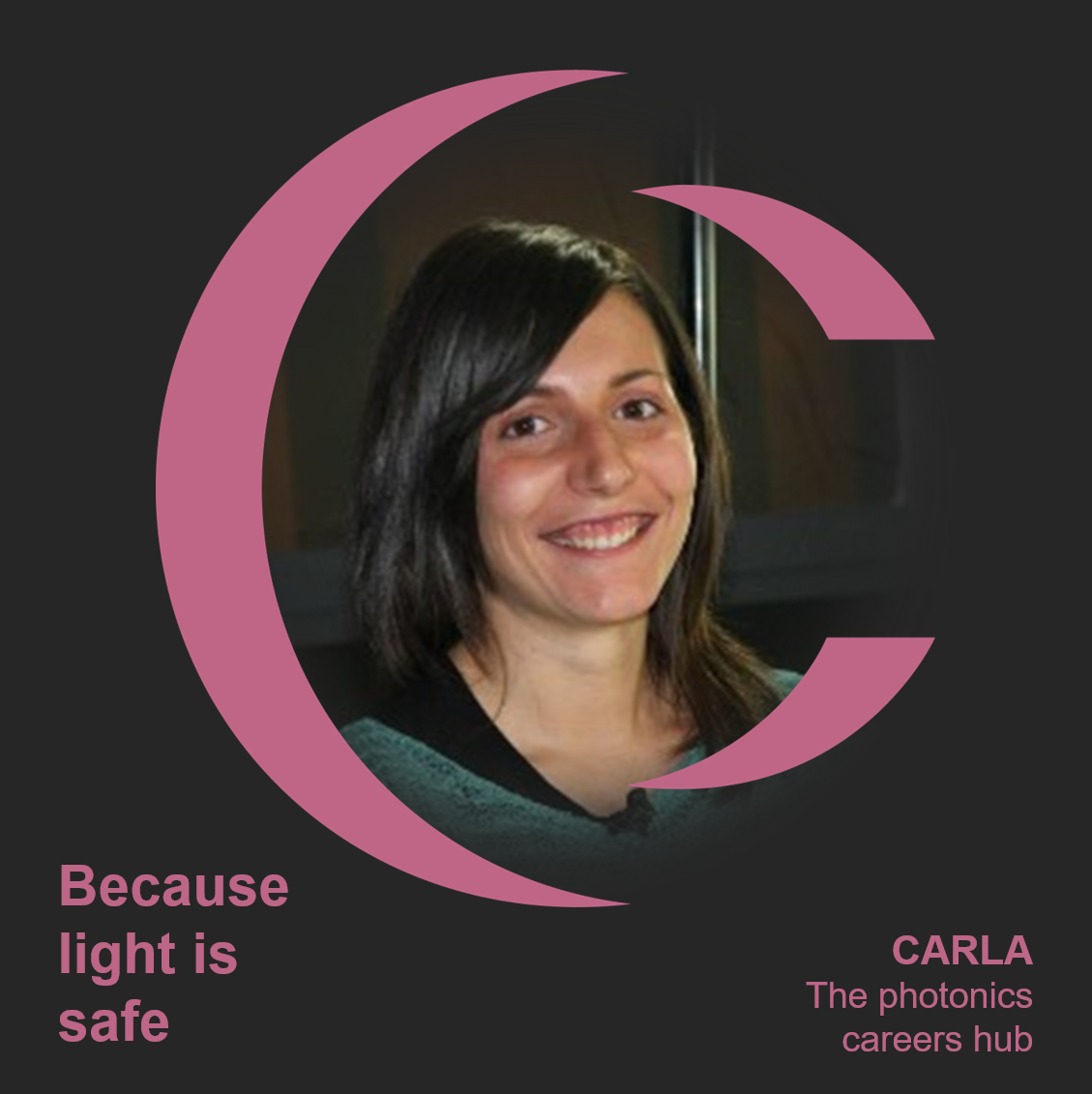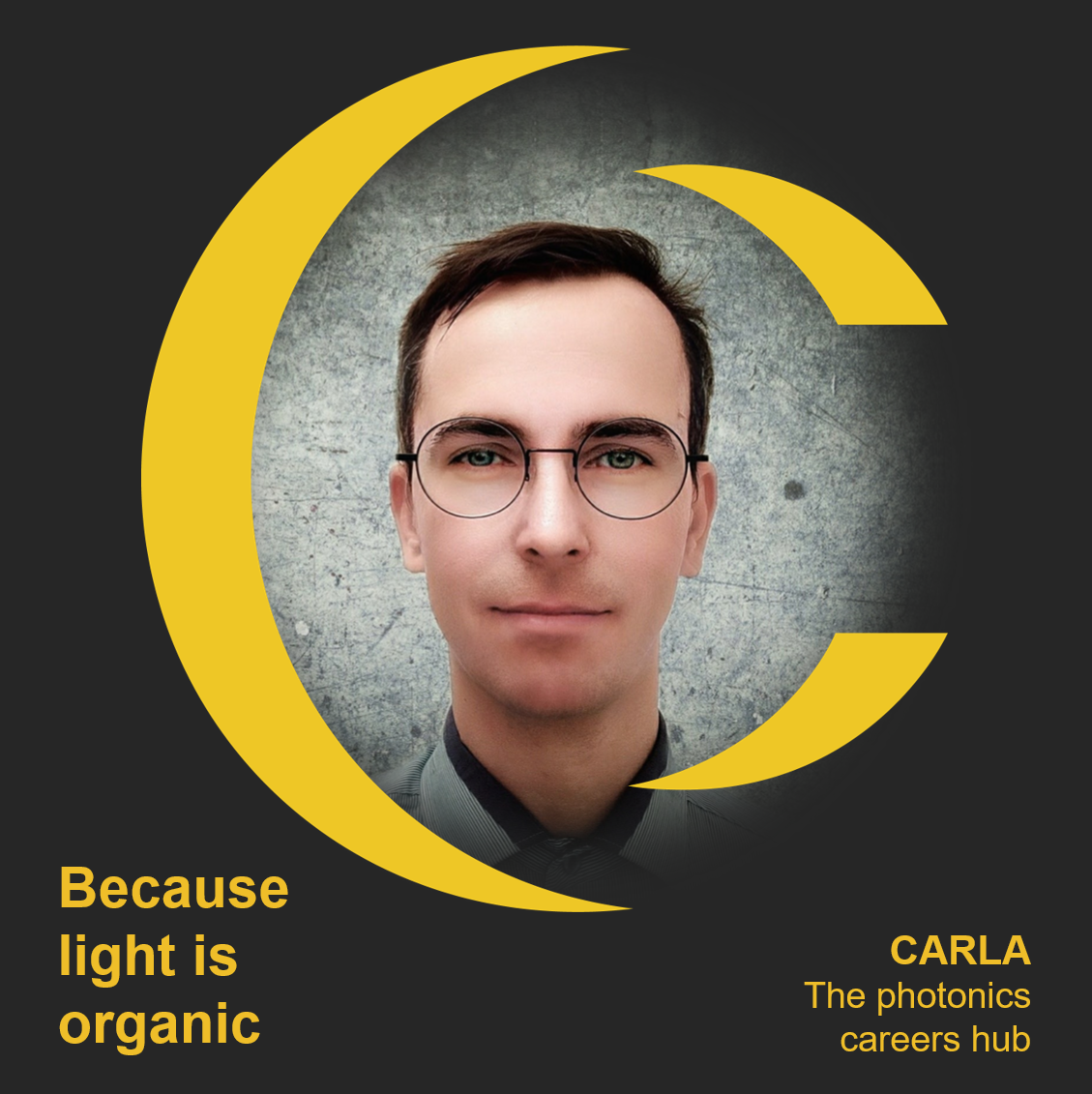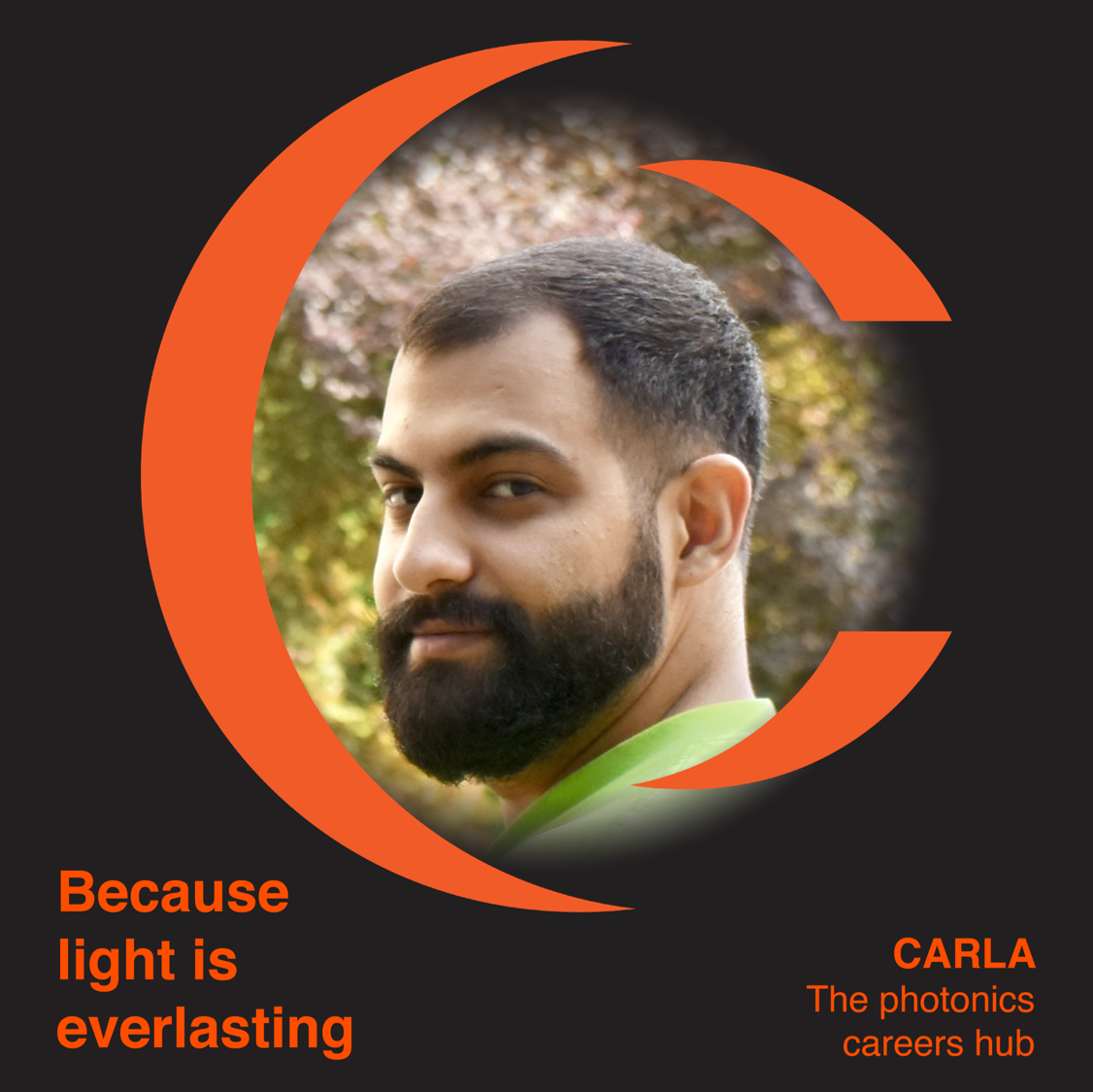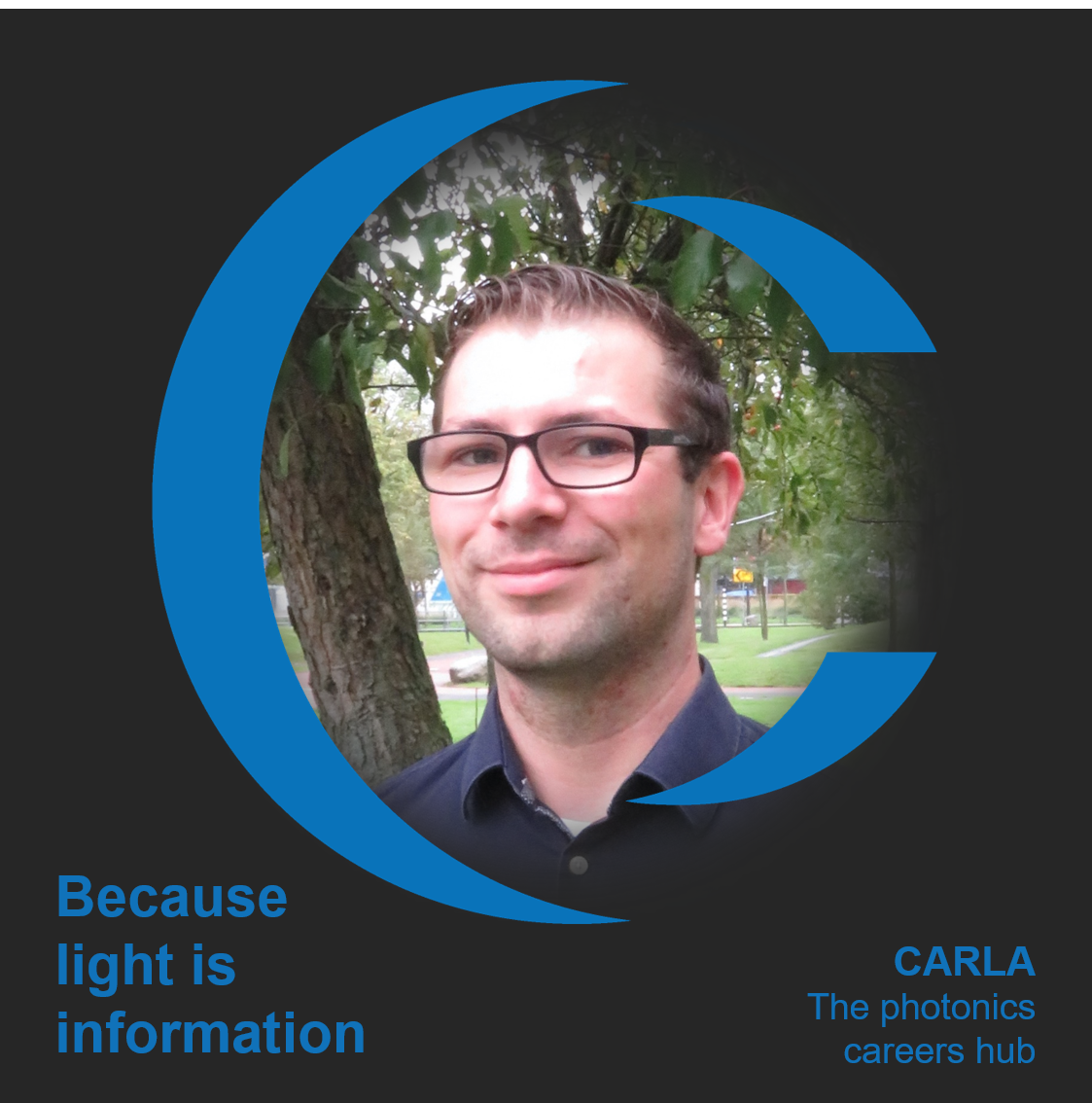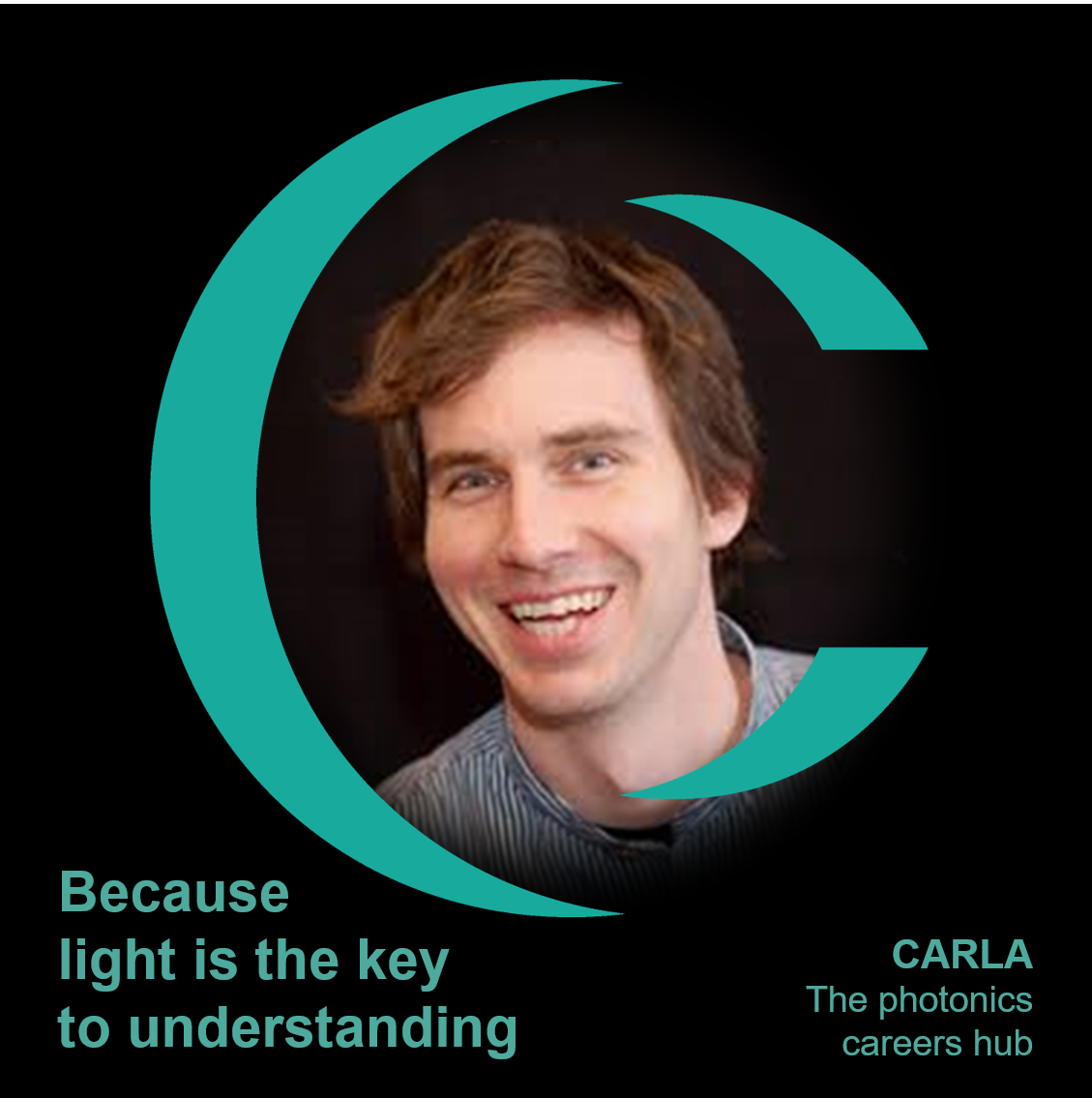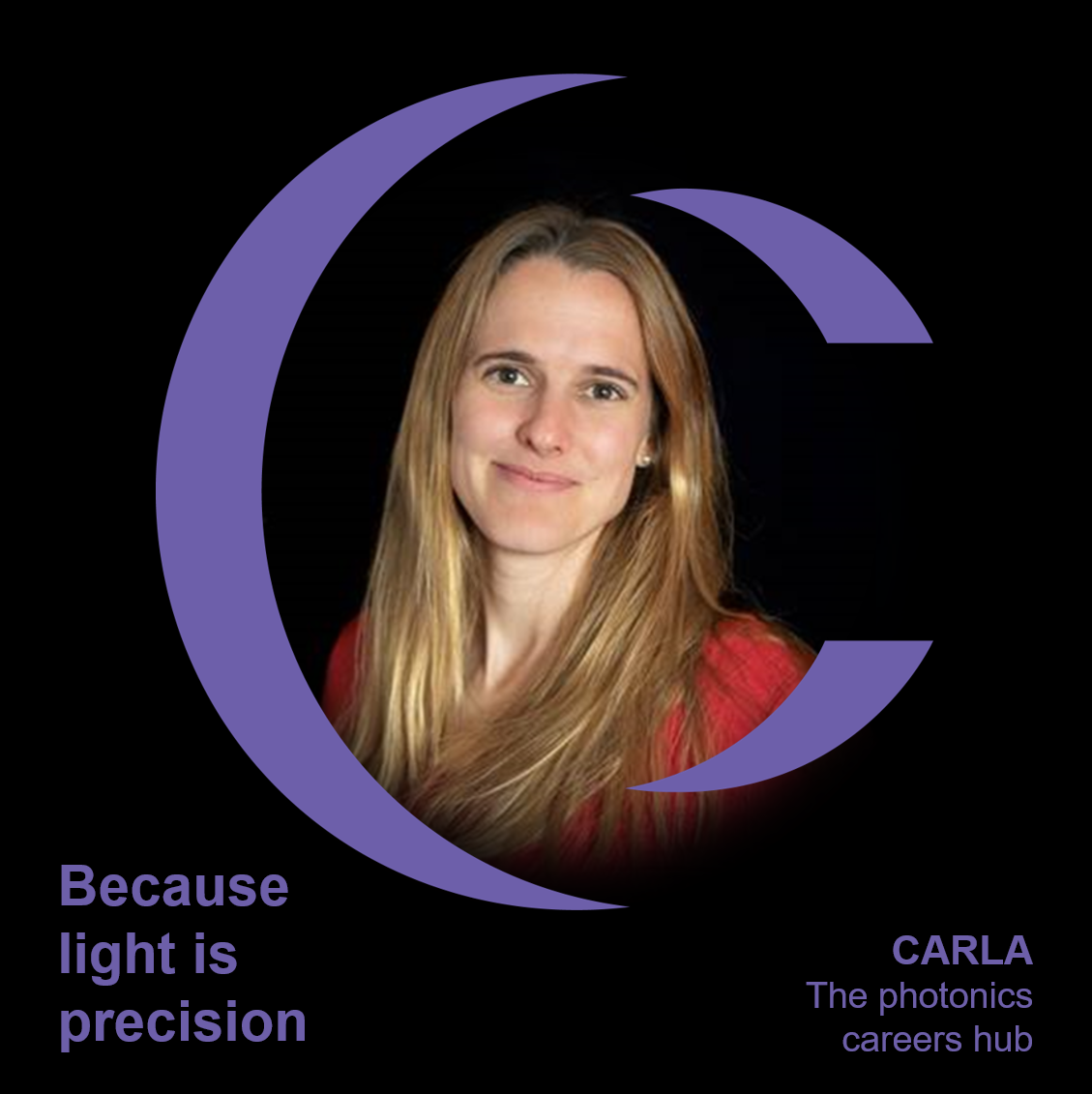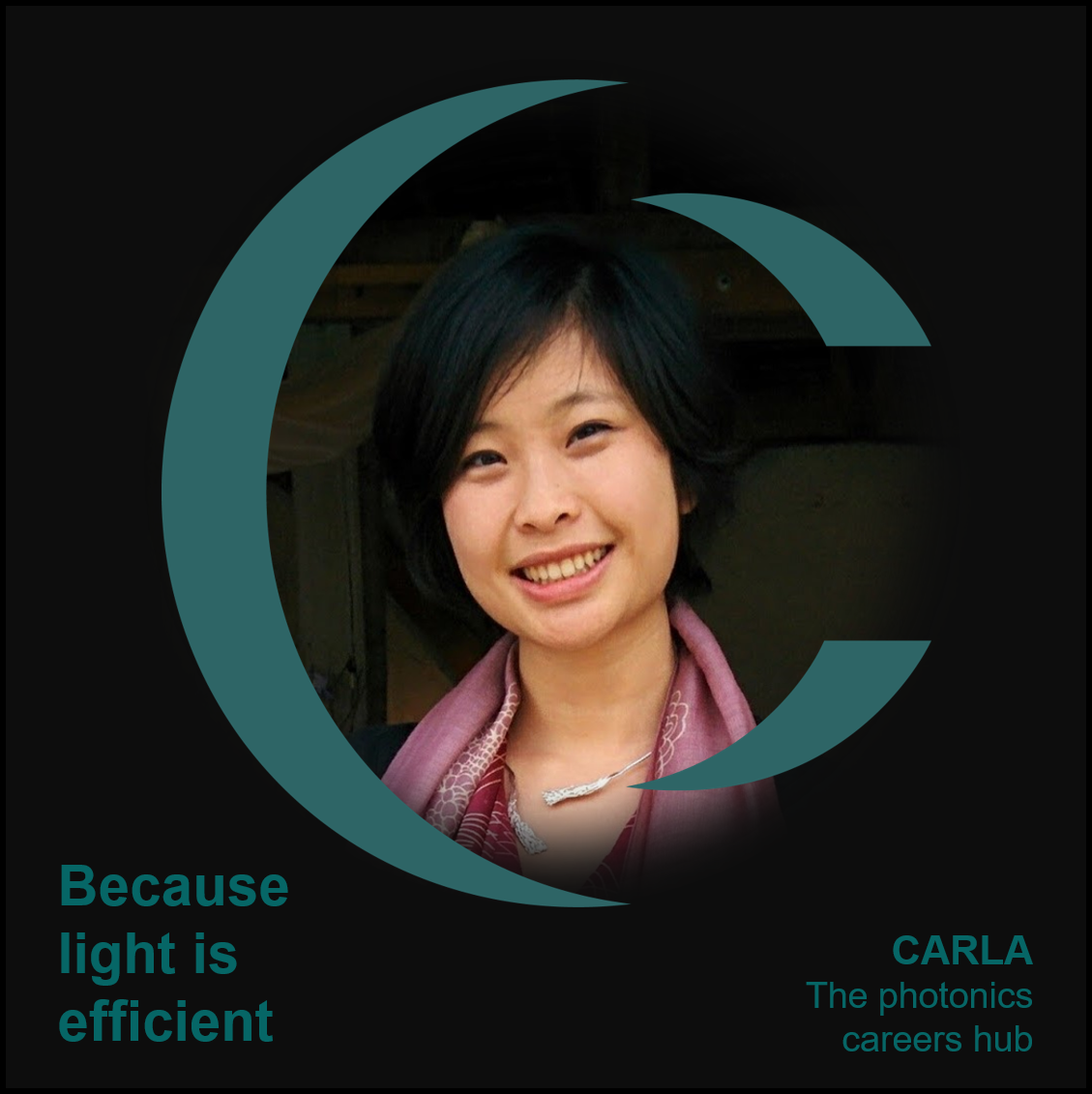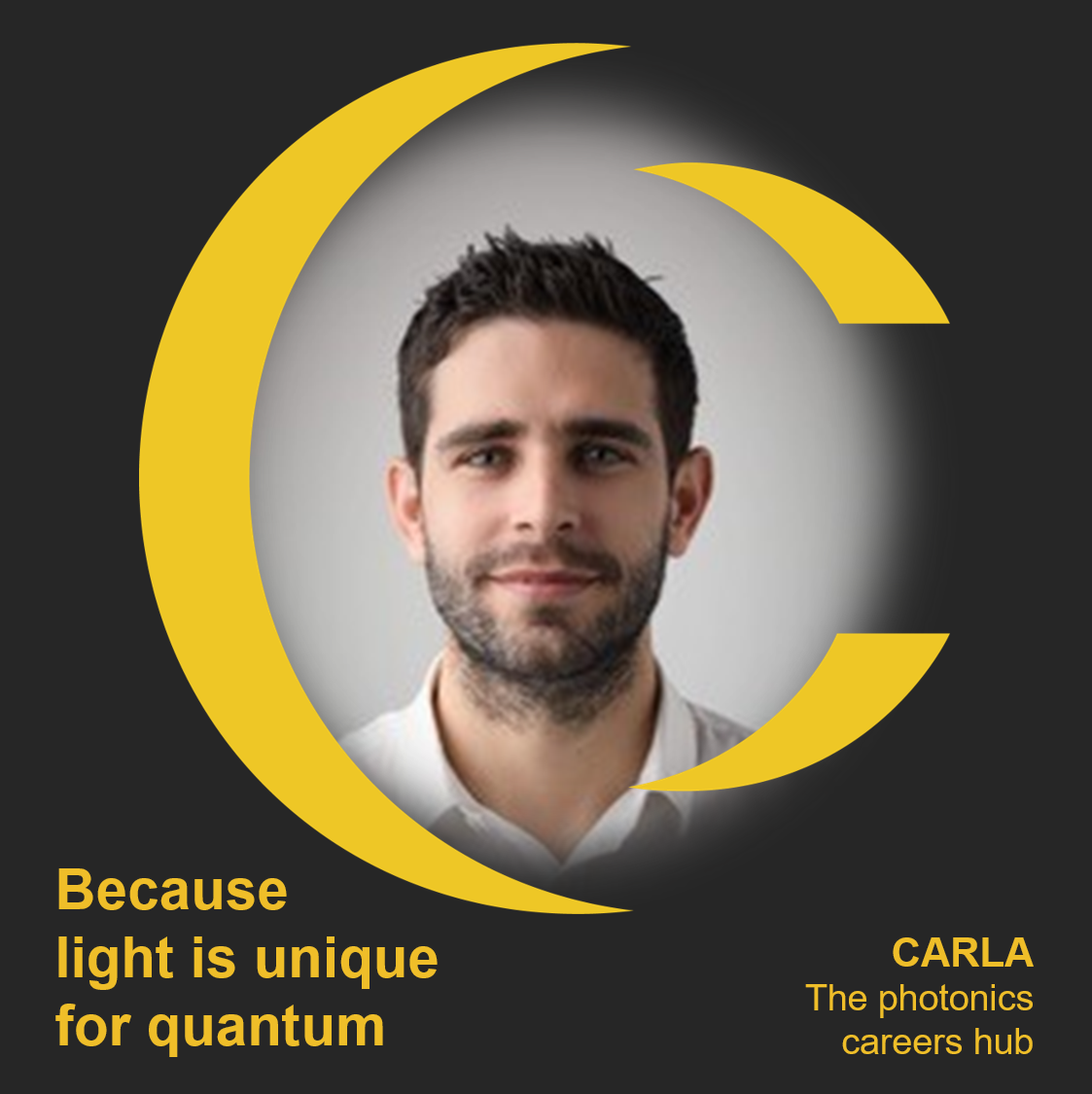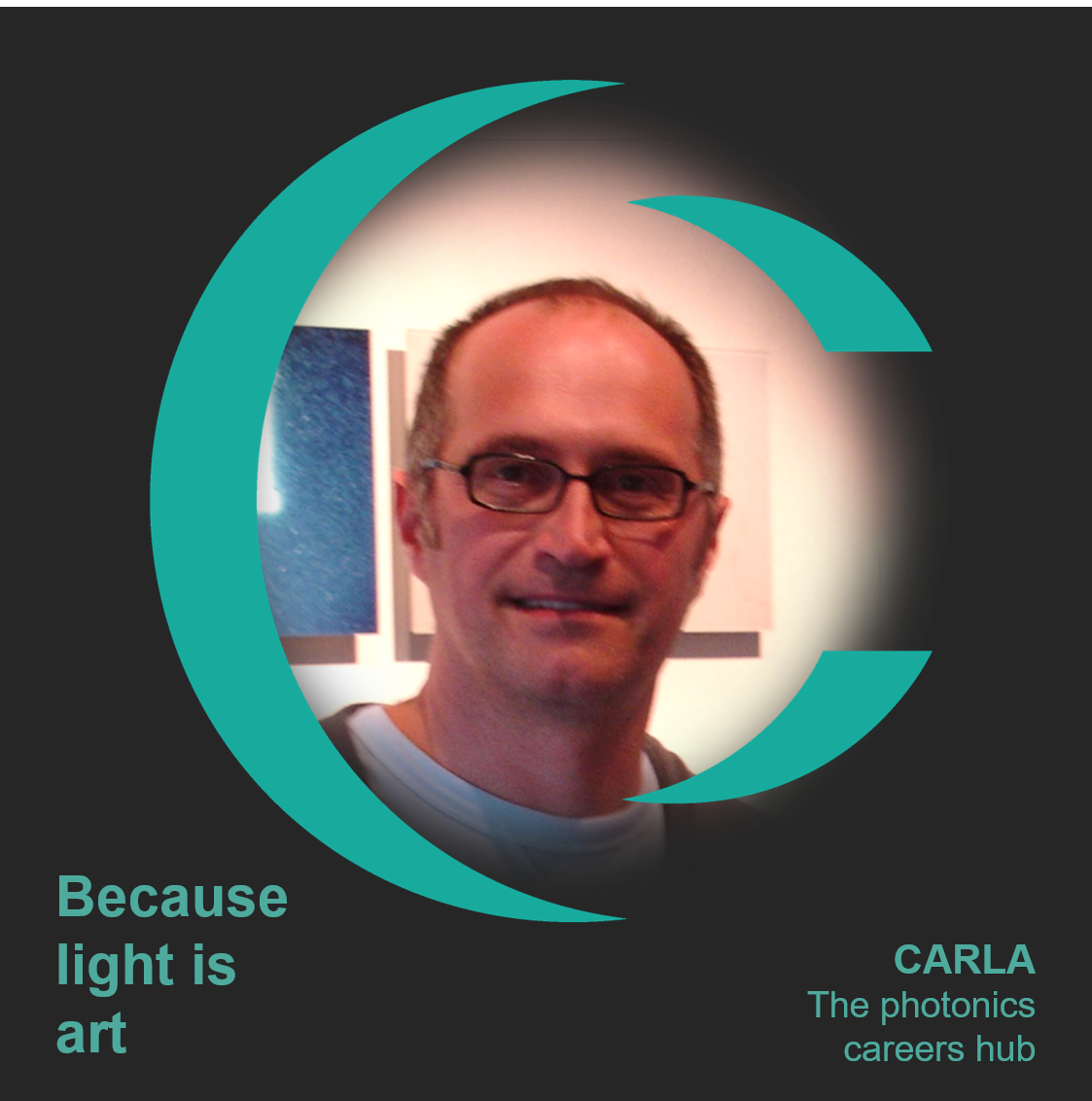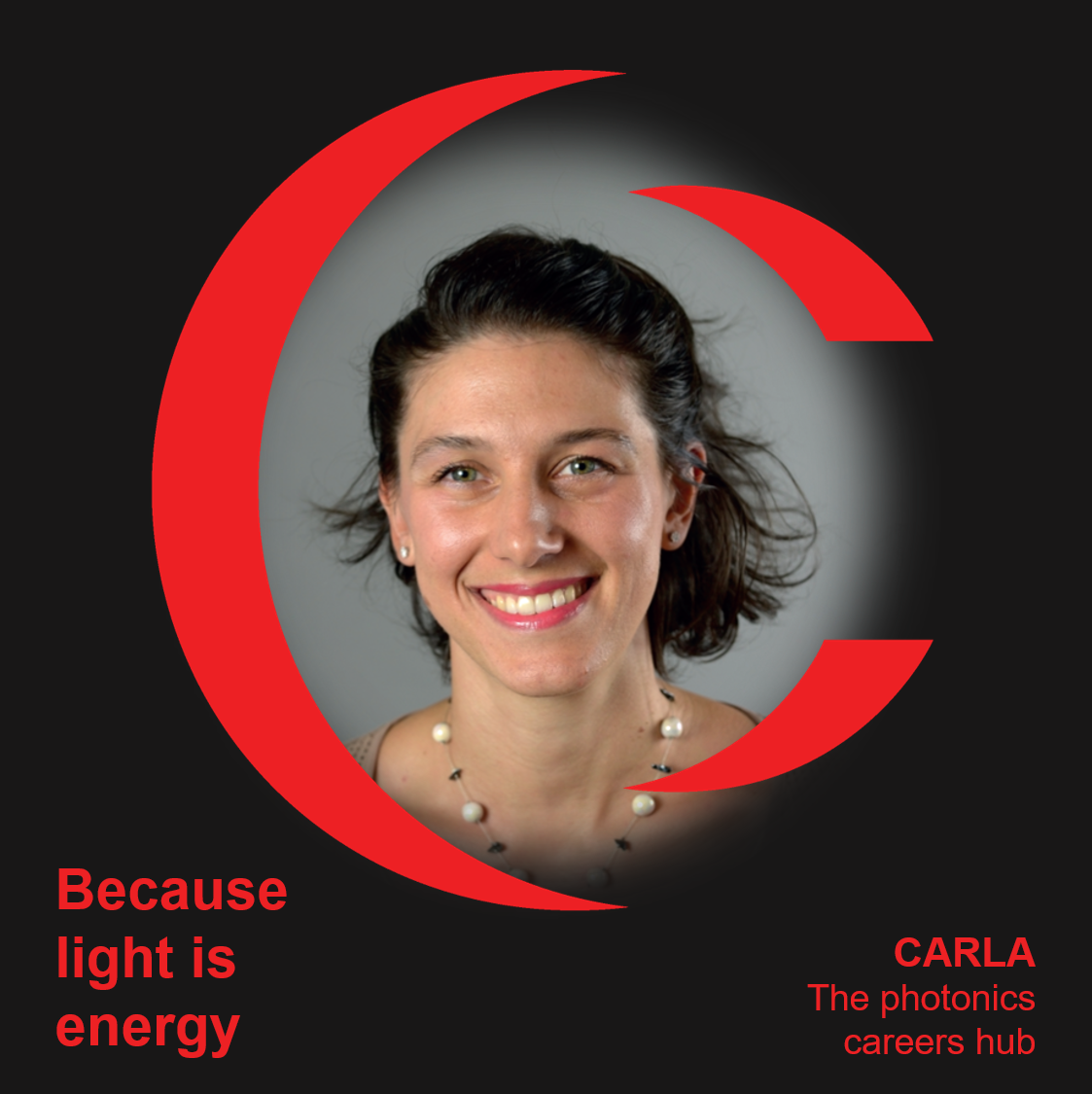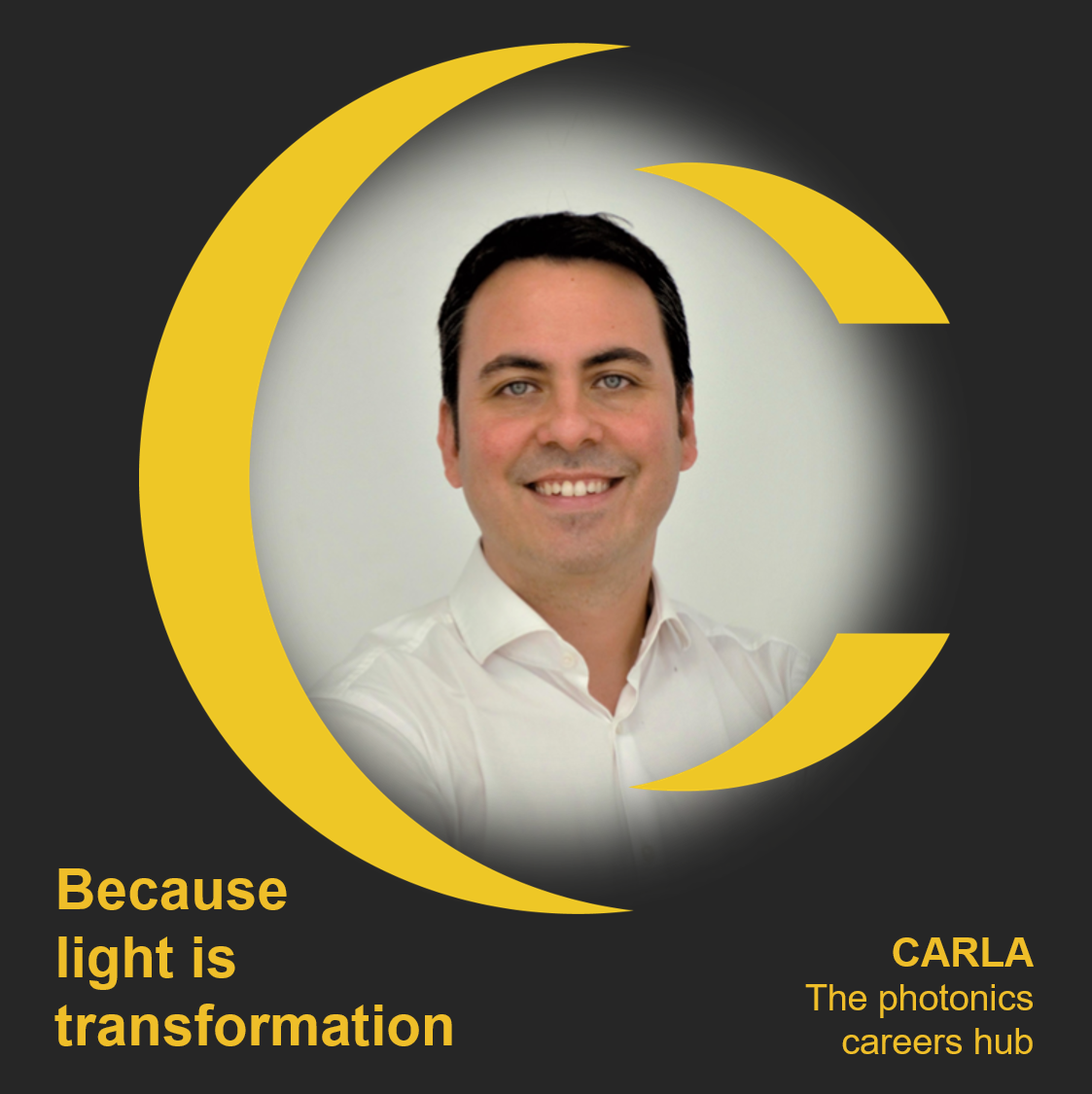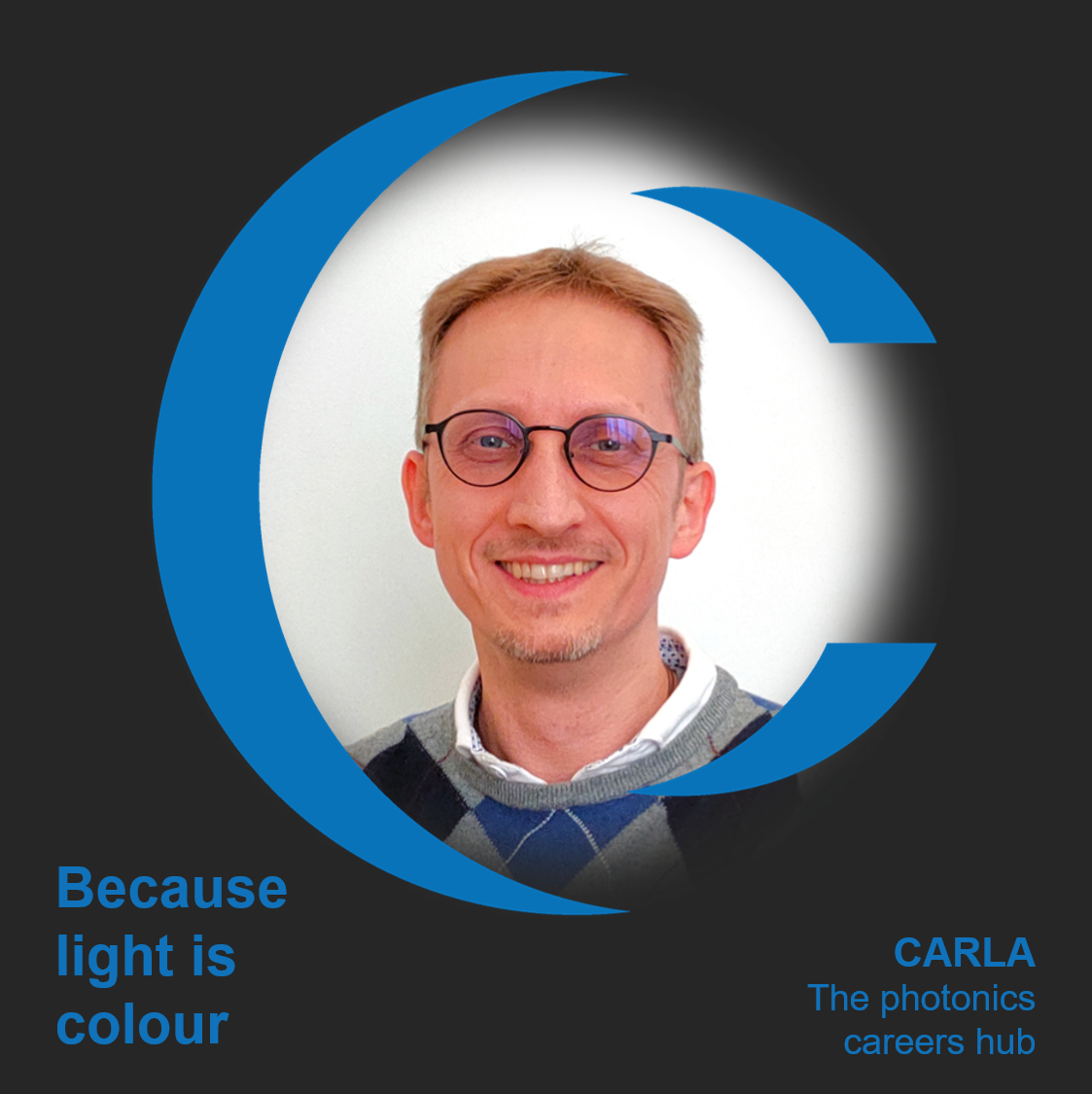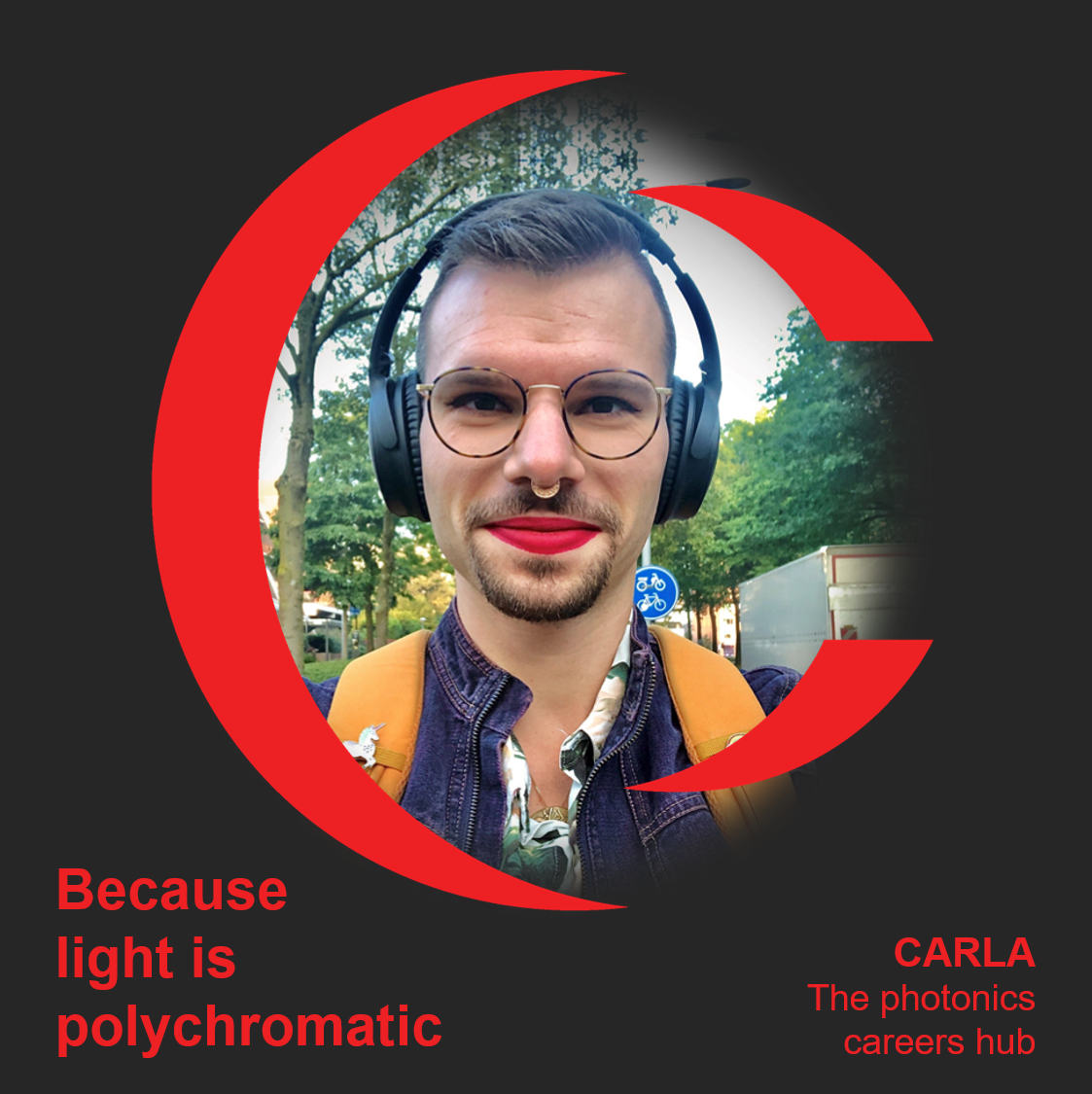Because light is…
In this section, we present short interviews with professionals in the photonics world, where they define what light means to them.
- Academia
- Industry
- Other
- Engineering
- Telecommunications
- Health
- Agrifood
- Art
- Energy
- Research
- Technology-Transfer
- Business-Development
- Communication
- IP
- Technical
- Diversity
- Women
- Skills
Because light is ubiquitous tech
For CARLA supporter Alba B. Rosado light is… UBIQUITOUS TECH!
Alba is a technologist passionate about light and specialised in fundraising, technology transfer, IP management, international project coordination and the organisation of technology-driven events.
Her background is in Telecom Engineering and she is part of the Knowledge and Technology Transfer team at ICFO (Barcelona), where she puts all her energy in maximising the impact associated to the photonic technologies they develop based on advanced materials, and ensure they can arrive to disrupt the market and society.
Because light is innovation
For Dr. Stephanie Cheylan light is… INNOVATION!
Stephanie is a physicist with international research experience in the field of materials science focusing on the development of new light sources. Her interest in technology transfer activities and the motivation to help protect scientific advancements and innovations in the research world has led her to change her career in applied physics research to patent law. Stephanie is now working as a Patent Engineer at Grünecker IP Law Firm. Her work involves providing active support of new developments from the idea to the granted property right, by drafting patent applications, conducting patent grant proceedings before the French, German and European patent offices. She tells us that the combination of law and technology makes her job a fascinating and challenging one being always at the edge of innovation.
Because light is a bright and colorful experience
For Dr. Ingrid Jonak-Auer light is… A BRIGHT AND COLOURFUL EXPERIENCE!
Ingrid is a Semiconductor Physicist specialized in the development of optical sensors at ams AG, Austria. She and her team of R&D engineers are working on advanced optical sensor solutions, which define our world today – from smartphones and mobile devices to safer driver-assisting vehicles, smart homes and buildings, industrial automation, and medical diagnostics. They are shaping the world with sensor solutions, leading the way in forging continuous connections between people and technology, and envisioning a seamless experience between the two.
Because light is a tool for change
For Dr. Aitor Villafranca Velasco light is… A TOOL FOR CHANGE!
Aitor is a postdoctoral researcher at the Spanish National Research Council, where he develops photonic integrated circuits enhanced through subwavelength metamaterials. He is also the founder of Alcyon Photonics, a spin-off company committed to bringing this technology to the rapidly-growing photonics market.
Moreover, he is one of the founding members of Prisma Ciencia, a national non-profit association fighting for LGBTQIA+ equality in STEM.
He believes integrated optics are a powerful tool for technological change, from broadband communications to microspectrometers or lab-on-a-chip solutions. But in order to fulfill this potential, we have the responsibility to build a welcoming and equalitarian field for diverse researchers regardless of their gender, race, sexual orientation or gender identity.
Because light is fascinating
For CARLA supporter Dr. Jeannette M Fine light is… FASCINATING!
Jeannette got her PhD in physics in the USA. Over her career as post-doctoral researcher and commercial R&D, she has worked on a wide range of projects in the USA and the UK, including developing software for atmospheric gas detection and for a laser testing facility. Her experience in both the academic and private sector led her to the Dr. Eyal Bressler & Co. patent office in Israel, where she is now an IP Scientific Associate and uses her knowledge and sense of humour to protect new innovations in photonics, including a more efficient solar energy absorption surface.
Because light is fast
For Dr. Matteo Lucchini light is… FAST! So fast it enables us to see the movements of the electrons.
Matteo is an assistant professor at the Physics Department of Politecnico di Milano. His research team is one of the leading groups in the generation of single attosecond pulses of light – the shortest laser pulses ever produced, few billionths of a billionth of a second – and their application to study electron dynamics in solids. These ultrafast snapshots can help understand and control the electro-optical properties of the matter and could potentially change the way solar cells and semiconductor devices are built.
In 2019 Matteo was awarded the prize Alfredo di Braccio for young Italian physicists and the Fresnel prize for outstanding contributions in the field of Attosecond Science. At present, he is in charge of the ERC project AuDACE, aimed at studying the very first instants of light-matter interaction.
Because light is safe
Dr. Rebecca Re is a physical engineer working at the department of physics of Politecnico di Milano, where light is used for non-invasive biomedical applications, as optical mammography and tissue oximetry. In particular, Rebecca employs near infrared light to investigate brain functions and the oxygen metabolism of muscles in healthy subjects and patients. Her expertise ranges from the devices development to the clinical translation of the prototypes, and she also closely collaborates with physiologists and physicians for the data analysis and interpretation.
Rebecca would like to extend the use of near infrared spectroscopy (fNIRS) towards new applications and overcome technological limitations… Because light is SAFE!
Because light is organic
For Prof. Martin Weis light is… ORGANIC! Because light can come from organic material too.
Martin is a professor at the Slovak University of Technology, however his work with light started at the university in Japan. His lab is focused on the light generated in an organic matter – the organic light-emitting diodes (OLEDs). These optoelectronic devices can be used to make displays for smartphones or TVs since they provide infinite contrast (true black), lower battery drain, and excellent colour accuracy. Furthermore, it is possible to make foldable displays or transparent screens suitable for smart glasses and smart windows.
The OLED displays as stickers are already coming to replace labels on daily used products as soft-drink bottles and making moving pictures anywhere!
In 2013 Martin was awarded the price “Scientist of the year“ by the government of Slovakia and in 2019 the Prize for scientific impact by the Slovak Physical Society for outstanding contributions in the field of organic electronics.
Because light is everlasting
For Ir. Mehdi Feizpour light is…. EVERLASTING and never becomes irrelevant.
We encounter light the exact moment we are born and open our eyes. When we grow older, we “see” a larger number of instances where light and its effects are present: the color of butterflies’ wings, the stars in the night’s sky, and a lot more. Such an ubiquitous and perpetual presence demands a ceaseless investigation.
Hence why Mehdi has been feeling a strong attraction to the field of photonics. He has recently decided to continue his studies with a PhD in the Biophotonics group of B-PHOT team at the Free University of Brussels. Working on interdisciplinary projects, Mehdi will gain experience to apply his light-related knowledge to biological and medical areas. What drives him to pursue this goal intently is the vast social impact. From medical imaging to food quality control, light has been tamed to improve our wellbeing. Nevertheless, there are numerous people working with light. Each of them has their own purposes and impulses. A lot remains to be investigated and a plethora of applications to be explored.
Because light is information
Jaap Sterrenburg has a rather unique trajectory. After his bachelor in mechanical engineering, he worked as an R&D engineer in the maritime and offshore industry for several years. During this time, he transitioned towards the topic of control & simulation. As he was eager to learn more about this topic and specialize further towards a career in control theory and mechatronics, he decided to enroll for a master’s degree in Systems & Control at TUDelft.
A professor introduced him to the inspiring field of adaptive optics as an application of control in photonics to correct images from telescopes. As he grew a strong interest in imaging and light, for his final master project he joined the team of the Smart Optics Lab at TU Delft. There he conducted research on Super-Resolution Fluorescence Microscopy systems to localize molecules in cells at the nano-level.
He was able to combine his prior understanding of mechatronics and his newly gained knowledge on optics to build one of these new optical instruments. The microscope paired a smart light source and an efficient optical design, and the optimized use of single photons improved the amount of information that could be obtained from the images.
As an image is built by a collection of photons, for Jaap light is… INFORMATION!
Because light is the key to understanding
For Dr. Cord Arnold light is… THE KEY TO UNDERSTANDING!
Cord tells us that he was always interested in physics and was early determined to go for that at university. He graduated in physics from the Leibniz University Hannover (Germany) in 2003 and obtained his PhD in 2007 working on nonlinear laser tissue interaction for micro/nano manipulation and refractive surgery applications (i.e. eye surgery for vision correction).
Since then Cord oriented his career towards ultrafast optics, working with femtosecond laser technology and its applications. During his postdoc at Institut d’Optique (Paris, France) he investigated how to further compress energetic femtosecond laser pulses in time.
When he started as a faculty member in Lund (Sweden), he focused on the shortest light pulses that can today be obtained, the attosecond pulses. In his current research, he develops laser technology for efficient and versatile attosecond pulse sources and he applies them to understand fundamental light-matter interactions happening on ultrafast time scales.
He is proud to have the privilege to teach future generations of photonics specialists both in his research and with his teaching. Cord is now the director of the Master’s programme in photonics at Lund University and he educates students from many parts of the world in exciting topics like optical design and medical optics!
Because light is precision
For physicist Dr. Barbara Buades light is… PRECISION!
Barbara did her PhD in photonics at ICFO (Barcelona) and straight after her graduation she co-founded the start-up MEETOPTICS with the idea of helping the photonics community. MEETOPTICS is a highly customizable search engine specialized in photonics where engineers, scientists and innovators can find components and technologies amongst verified worldwide suppliers.
Barbara is the CEO but, as it commonly happens for start-ups, her role within MEETOPTICS is multifaceted. She is in charge of planning the roadmap of new developments, looking for investors, leading the sales and marketing strategic actions, analysing the finances and recruiting new talent to join this adventure. The ability to handle very different tasks is part of the charm and the challenge when establishing a new business.
Barbara is passionate about learning and pushing her own boundaries to bring innovation to society. With MEETOPTICS she has found a way to merge the business and technology worlds, leveraging her knowledge in quantum physics, ultrafast optics and material science, and help others find solutions to develop their applications more efficiently. That is why Barbara became a member of the technological innovation cluster secpho, since collaboration is key to innovation!
Because light is efficient
For physicist Dr. Pu Jian light is… EFFICIENT!
Pu currently leads the product management and partnerships team at Cailabs. After a PhD in quantum optics, she joined the budding deep-tech company Cailabs specialized in beam shaping and took over the task to find out how their technology could help various industrial markets. Seven years later, her team has launched 4 product lines targeting markets ranging from optical telecommunications, industrial laser processing and defense optronics.
Photonics has been recognized as a Key Enabling Technology for Europe, and indeed light is the most efficient tool for many industrial applications, as it enables greener technology, better quality, and higher capacity in transmissions and processes. Pu believes that tailored beam shaping is photonics’ next disruptive enabler, and she strives to make it happen by building industrial partnerships integrating Cailabs’ cutting-edge technologies. She’s in charge of identifying which applications can benefit from beam shaping technologies, defining what are the features that should be included in Cailabs’ products, proposing how the products should be marketed and establishing partnerships with key actors in the market.
In addition to her role in Cailabs, Pu is also the exploitation manager in the H2020 project Custodian that aims to achieve better efficiency and lower costs in laser manufacturing. Based on her skills and expertise on business development and IPR issues, Pu collaborates with the European project partners to elaborate the business plan and IP protection strategy.
Because light is unique for quantum
For Dr. Carlos Abellan light is the most useful piece of physics for building quantum products!
Carlos is co-founder and CEO of Quside, a start-up building quantum technologies for safer connectivity and more powerful computation.
Carlos, who got his PhD from ICFO, is coinventor of 6+ patent families and co-author of various scientific articles. He has also received multiple awards for his work, including the MIT Innovators Under 35 Europe in 2018.
Carlos was among the invited speakers of the entrepreneurs panel at the first virtual CARLA camp organised by ICFO.
Because light is art
For artist Eric Michel light is… ART! It is a language allowing us to explore the frontier between the material and the immaterial.
Eric is a contemporary visual artist specialised in light. Following a path opened by famous light artists Yves Klein, James Turrell and Dan Flavin, Eric’s work, and particularly his fluorescent neon installations and videos, creates a vibrating space, in search for immateriality.
Eric was an art and cultural advisor in France for «2015 Year of Light» organized by UNESCO. On this occasion, he created the Arts & Sciences project at the Institut d’Optique Graduate School. He also created, in partnership with scientists from the French National Center for Scientific Research (CNRS), the monumental work Platonium that was presented in the courtyard of the City Hall in Lyon for the Festival of Lights in 2016, before travelling around the word, and landing again at the City of Sciences and Industries in 2018 in Paris.
Because light is energy
For Dr. Giulia Tagliabue light is ENERGY!
Giulia is a mechanical engineer who discovered photonics during her PhD studies at ETH Zurich. Combining her interest in energy technologies with nanophotonics engineering she investigated fundamental mechanisms of light absorption in metals and designed scalable solar absorbers (devices that convert the energy from the sun into heat).
After graduating, in 2015 she moved to Caltech as a postdoc. Here, in collaboration with the Joint Center for Artificial Photosynthesis (JCAP), she focused on the realization of photoelectrochemical devices that use solar energy to recombine water and carbon dioxide, one of the main greenhouse gases, and generate clean fuels. In particular Giulia focused on exploring the unique optical and chemical properties of tiny metallic structures.
As a faculty member at EPFL (Switzerland), she utilizes nanophotonics tools to study light-energy conversion mechanisms and to devise advanced architectures for light-energy storage devices.
Giulia is excited about the many opportunities that nanophotonics can open for clean energy technologies and she is looking forward to motivating a new generation of scientists and engineers, in particular young women, to work in this field!
Because light is transformation
For Sergio Saez light is… TRANSFORMATION!
Sergio is the cluster manager of secpho. He holds an MBA from ESADE and is an industrial engineer by the Universitat Politècnica de Catalunya, specialised in robotics. Before joining @secpho_cluster, Sergio was an entrepreneur himself, standing out for his entrepreneurial personality and his high ability to provide practical solutions in complex challenges.
His background allows him to understand the needs of secpho’s members to help them developing their businesses. In addition, Sergio collaborates sharing his experience and knowledge with prestigious business schools, such as ESADE and UPC School, and is a regular lecturer at the Master in Photonics-Photonics BCN.
Sergio is passionate about collaboration at all levels, facilitating intersectorial cooperation between all the agents involved in the innovative ecosystem such as SMEs, startups, research centres, investors and big corporations. Since he joined secpho in 2012, Sergio connected photonics technologies with more than 25 sectors to enhance the digitisation of the industry, resulting in more than 100 specific innovation project initiatives.
At the moment, he is leading secpho’s transformation from a photonics to a deep tech cluster, extending its sphere of influence to other Deep Technologies such as Artificial Intelligence, Quantum, Robotics and Blockchain in order to provide solutions to the complex challenges of 21st century society in a collaborative manner among its ecosystem. Therefore, Sergio considers light as means of transformation to a more sustainable, healthy and efficient society.
Because light is colour
For Dr. Cristian Manzoni light is… COLOUR!
Cristian is a Senior Researcher at the Institute for Photonics and Nanotechnology of the Italian National Research Council (CNR-IFN). In addition to his core job as a researcher, Cristian is very active in outreach, approaching photonics and its underlying science and technology to different audiences, including young minds, students and general public.
Cristian’s research activity deals with spectroscopy, which exploits light to study the processes occurring in matter and its properties. In fact he profits of two amazing properties of light: its colours (or spectrum) and its speed.
When the light hits an object, some of its colours get reflected or scattered and this is at the origin of all the mesmerising tints we see in the world, from the sky in a sunny day to the leaves in the fall. Beyond beauty, the colour and its changes also provide a wealth of information on the constituents of matter and on its evolution, that Cristian reveals with the help of the most advanced techniques of spectral imaging.
He also learnt to carve light to generate ultrashort pulses used to study ultrafast changes of colour, witnessing quick processes occurring in matter. Cristian exploits ultrashort light bursts to freeze ultrafast processes of nature, such as light harvesting by leaves and the primary events of vision, and unveil the enigma of their incomparable efficiency.
Because light is polychromatic
To celebrate the Pride Month 2022, we would like to share the story of Vì, PhD student at Eindhoven University of Technology in The Netherlands working on modelling surface light scattering, and what they learned during the COVID-19 lockdown: «First, some context. I was born in Sweden with a traditional male name. After graduating with a MSc in engineering physics, I decided to pursue a career in academia. I knew I wanted to go abroad and see the world, and eventually found my way to the Netherlands. At this point, I was still using my birthname and was mostly queer “in my spare time”.
During the lockdown, I had an unprecedented amount of time to myself. Being stuck in my own mind was at first quite scary and overwhelming, but I will borrow the words of Jamie Clayton as Nomi in Sense8: “The real violence, the violence I realized was unforgivable, is the violence we do to ourselves when we’re too afraid to be who we really are”.
So I changed my name and pronouns (they/them) on Facebook, I sent that scary email to my bosses and sent a message to my colleagues. Eventually, I also applied for a legal name-change. And so here I am, still with my job and still presenting at conferences, still freaking out about only having two years left [to finish the PhD thesis], but as I really am… so much has changed, but at the same time so little has changed.
My story, the stories of my cis-het colleagues, the stories of women in STEM, and if you want, your story, all fit within photonics – after all, LIGHT IS POLYCHROMATIC.»
